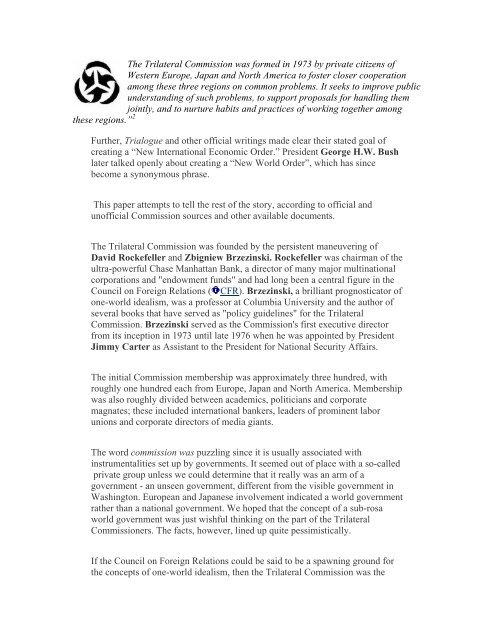70-years-chart-illustrates-the-dominance-by-the-cfr-trilaterals-bilderbergers
70-years-chart-illustrates-the-dominance-by-the-cfr-trilaterals-bilderbergers
70-years-chart-illustrates-the-dominance-by-the-cfr-trilaterals-bilderbergers
You also want an ePaper? Increase the reach of your titles
YUMPU automatically turns print PDFs into web optimized ePapers that Google loves.
The Trilateral Commission was formed in 1973 <strong>by</strong> private citizens of<br />
Western Europe, Japan and North America to foster closer cooperation<br />
among <strong>the</strong>se three regions on common problems. It seeks to improve public<br />
understanding of such problems, to support proposals for handling <strong>the</strong>m<br />
jointly, and to nurture habits and practices of working toge<strong>the</strong>r among<br />
<strong>the</strong>se regions.” 2<br />
Fur<strong>the</strong>r, Trialogue and o<strong>the</strong>r official writings made clear <strong>the</strong>ir stated goal of<br />
creating a “New International Economic Order.” President George H.W. Bush<br />
later talked openly about creating a “New World Order”, which has since<br />
become a synonymous phrase.<br />
This paper attempts to tell <strong>the</strong> rest of <strong>the</strong> story, according to official and<br />
unofficial Commission sources and o<strong>the</strong>r available documents.<br />
The Trilateral Commission was founded <strong>by</strong> <strong>the</strong> persistent maneuvering of<br />
David Rockefeller and Zbigniew Brzezinski. Rockefeller was chairman of <strong>the</strong><br />
ultra-powerful Chase Manhattan Bank, a director of many major multinational<br />
corporations and "endowment funds" and had long been a central figure in <strong>the</strong><br />
Council on Foreign Relations ( CFR). Brzezinski, a brilliant prognosticator of<br />
one-world idealism, was a professor at Columbia University and <strong>the</strong> author of<br />
several books that have served as "policy guidelines" for <strong>the</strong> Trilateral<br />
Commission. Brzezinski served as <strong>the</strong> Commission's first executive director<br />
from its inception in 1973 until late 1976 when he was appointed <strong>by</strong> President<br />
Jimmy Carter as Assistant to <strong>the</strong> President for National Security Affairs.<br />
The initial Commission membership was approximately three hundred, with<br />
roughly one hundred each from Europe, Japan and North America. Membership<br />
was also roughly divided between academics, politicians and corporate<br />
magnates; <strong>the</strong>se included international bankers, leaders of prominent labor<br />
unions and corporate directors of media giants.<br />
The word commission was puzzling since it is usually associated with<br />
instrumentalities set up <strong>by</strong> governments. It seemed out of place with a so-called<br />
private group unless we could determine that it really was an arm of a<br />
government - an unseen government, different from <strong>the</strong> visible government in<br />
Washington. European and Japanese involvement indicated a world government<br />
ra<strong>the</strong>r than a national government. We hoped that <strong>the</strong> concept of a sub-rosa<br />
world government was just wishful thinking on <strong>the</strong> part of <strong>the</strong> Trilateral<br />
Commissioners. The facts, however, lined up quite pessimistically.<br />
If <strong>the</strong> Council on Foreign Relations could be said to be a spawning ground for<br />
<strong>the</strong> concepts of one-world idealism, <strong>the</strong>n <strong>the</strong> Trilateral Commission was <strong>the</strong>


